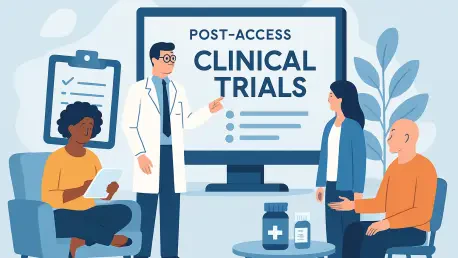In the realm of clinical research, the conclusion of a trial often feels like crossing a finish line, with key milestones such as database lock, the final monitoring visit, or the last patient out signaling closure for sponsors and contract research organizations (CROs). However, for the participants who invested their time, health, and often their hope in these studies, this endpoint ushers in a period of uncertainty about what happens next. The question of access to investigational products after a trial ends looms large, and historically, many sponsors have treated this as an ethical consideration rather than a firm obligation, leaving participants in limbo. Today, the regulatory landscape has shifted significantly, intertwining ethical responsibilities with compliance mandates. Neglecting to plan for post-trial access is no longer just a moral oversight; it represents a serious compliance failure that carries legal, contractual, and reputational risks for all stakeholders involved in clinical research.
1. When Ethics Transform Into Regulation
The assumption that regulatory responsibilities cease once data collection wraps up is a pervasive misunderstanding in clinical research. Under 21 CFR §312.50, U.S. sponsors are tasked with ensuring the proper conduct of investigations, a mandate that extends to protecting participants beyond active enrollment. This broad language reflects an expectation of ongoing safeguarding, not just during data gathering. Similarly, ICH E6(R3) §2.3 underscores that sponsors must prioritize the rights, safety, and well-being of trial participants across the entire study lifecycle. This convergence of ethics and regulation means that what was once merely encouraged by institutional review boards (IRBs) and ethics committees has now become a concrete compliance requirement. Failing to address participant needs after a trial concludes is no longer seen as a discretionary choice but as a breach of duty that regulators are increasingly prepared to scrutinize with rigor.
Moreover, international guidance reinforces this shift toward mandatory action. The Council for International Organizations of Medical Sciences (CIOMS) Guidelines, specifically Guideline 6 from 2016, explicitly states that sponsors must make provisions for continued access to investigational products when participants lack viable alternatives. This alignment between ethical bodies and regulatory frameworks sends a clear message: post-trial obligations are not optional gestures of goodwill but essential components of compliant trial management. Sponsors ignoring these expectations risk not only ethical criticism but also formal penalties during inspections. As regulators and ethics committees speak with a unified voice, the industry must adapt to treat participant protection as a continuous responsibility rather than a time-bound task, ensuring that no one is left vulnerable at a study’s end.
2. Legal and Contractual Oversights
Even with increasingly explicit regulatory guidance, many sponsors stumble over post-trial access due to gaps in contractual documentation. Clinical Trial Agreements (CTAs) often dedicate extensive detail to payment schedules, publication rights, and liability clauses, yet remain silent on what happens after a study closes. This lack of clarity fosters misunderstandings between sponsors and sites, with each party potentially assuming the other will handle continued product supply. Under 21 CFR §312.52, any delegation of responsibility must be clearly outlined and documented; ambiguity offers no shield against accountability. When contracts fail to address these obligations, the resulting disputes can escalate into significant compliance issues, exposing all parties to unnecessary risk and undermining the integrity of the research process.
Additionally, inconsistencies between documents compound the problem. If an informed consent form suggests that continued access will be provided if beneficial, but the CTA lacks corresponding terms, this discrepancy can be flagged during regulatory reviews. FDA warning letters frequently cite such misalignments as evidence of inadequate oversight, turning a simple oversight into a formal compliance violation. The lesson is evident: sponsors must ensure that all agreements and participant-facing materials align on post-trial expectations. Without precise language, what begins as a contractual gap can spiral into legal exposure, damaging trust and inviting scrutiny. Addressing these blind spots proactively is essential to prevent avoidable conflicts and maintain regulatory standing in an environment where precision is paramount.
3. Reputational Risks and Fallout
Beyond regulatory repercussions, neglecting post-trial access can inflict severe reputational damage on organizations involved in clinical trials. In an age of rapid digital communication, stories of participants being left without support after a study ends can spread swiftly through media channels and gain traction among patient advocacy groups. Such negative publicity often results in public outrage, shareholder scrutiny, and widespread criticism on social media platforms, sometimes overshadowing even the most promising trial outcomes. The impact of these narratives can tarnish a company’s image, portraying it as indifferent to participant welfare and prioritizing profit over people, a perception that is difficult to reverse once it takes hold in the public consciousness.
Furthermore, the consequences extend into future research endeavors. Communities that feel abandoned after participating in trials may become wary of future studies, leading to recruitment challenges for subsequent projects. Physicians, too, may hesitate to refer patients if they perceive a lack of commitment to post-trial care, while regulatory bodies might adopt a more stringent stance during protocol approvals. This ripple effect can hinder an organization’s global research portfolio, as trust eroded in one region impacts operations elsewhere. The reputational cost of failing to prioritize participant access after trials is a stark reminder that ethical lapses can have far-reaching implications, affecting not just public perception but also the practical ability to conduct future research effectively.
4. The Human Toll
At the heart of the discussion around post-trial access lies the profound human impact of neglecting participant needs. Individuals who experience clinical benefits from investigational products during a trial may face rapid health declines if access is abruptly withdrawn at the study’s conclusion. This not only affects the participants directly but also shatters the trust of families and broader communities in healthcare and research institutions. When research is perceived as exploitative—using participants for data and discarding their needs afterward—the damage extends beyond a single study. It undermines the entire clinical research ecosystem, making it harder to foster willing participation in future trials and eroding the foundation of trust necessary for medical advancement.
Regulatory and ethical bodies recognize this harm as preventable, not inevitable. Under 45 CFR §46.111(a)(2), U.S. IRBs are mandated to minimize risks to subjects, viewing sudden discontinuation of beneficial treatments as a foreseeable threat rather than a neutral outcome. Courts and communities increasingly hold the same perspective, treating participant welfare as a non-negotiable priority. The loss of faith resulting from inadequate post-trial planning is a stark warning to the industry: ignoring human consequences is not just a compliance failure but a betrayal of the very purpose of clinical research. Protecting participants after a trial ends is essential to preserving the integrity and credibility of the scientific process, ensuring that advancements do not come at the expense of those who make them possible.
5. Designing Proactive Compliance Frameworks
Rather than resorting to damage control through public apologies or last-minute fixes following regulatory findings, the industry must embed post-trial access into compliance frameworks from the earliest stages of trial planning. Reactive measures after negative publicity or inspections are insufficient; anticipatory design is the key to avoiding pitfalls. A structured approach that integrates legal, operational, and ethical considerations can transform post-trial access from a potential liability into a managed responsibility. By addressing these obligations upfront, sponsors, CROs, and sites can mitigate risks and align with regulatory expectations. The following steps provide a practical roadmap for building robust post-trial access plans that prioritize participant welfare and compliance.
The first critical step is financial planning during protocol creation. Post-trial costs must be factored into budgets at the design phase, not treated as an afterthought once a study concludes. This includes allocating resources for continued product supply alongside expenses for monitoring and pharmacovigilance. Regulators often evaluate a protocol’s feasibility based on whether such planning is evident, particularly in therapeutic areas where withdrawal poses significant health risks. Early budgeting demonstrates foresight and commitment to participant safety, reducing the likelihood of compliance issues later. By embedding these costs into the initial framework, organizations can avoid the scramble for resources post-trial and ensure a seamless continuation of care where necessary.
Next, detailed contract specifications are non-negotiable. CTAs and vendor agreements must explicitly outline responsibilities for post-trial supply, addressing who provides access, for how long, under what conditions, and at whose expense. Under 21 CFR §312.52, delegation of duties requires clear documentation; vague terms are indefensible in the face of scrutiny. Precision in contracts prevents misunderstandings between parties and establishes a solid foundation for accountability. Without such clarity, the risk of disputes and regulatory findings increases, potentially derailing a trial’s legacy. Ensuring that all agreements reflect post-trial commitments is a fundamental step in safeguarding compliance and maintaining operational harmony.
Harmonizing consent documents is equally vital. Informed consent forms must accurately convey what participants can expect after a trial ends, avoiding overpromises that create liability or unclear language that breeds distrust. The wording should align precisely with the CTA and protocol to prevent discrepancies, as these are often scrutinized during FDA and EMA inspections. Misaligned expectations can lead to participant frustration and regulatory penalties, undermining the trial’s credibility. By ensuring consistency across all documentation, sponsors can build trust with participants and demonstrate a commitment to transparency, a cornerstone of ethical research that also fortifies compliance standing.
Proactive regulatory and ethics collaboration sets the stage for smoother trial execution. Engaging with regulators and ethics committees early helps clarify expectations and requirements around post-trial access. In certain jurisdictions, particularly in low- and middle-income countries (LMICs) where standard care options may be limited, such commitments can be a prerequisite for approval. Anticipating these demands prevents delays and disputes down the line, allowing sponsors to navigate complex regulatory landscapes with confidence. Early dialogue fosters alignment and reduces the risk of last-minute hurdles, ensuring that participant access is planned and approved as an integral part of the trial process.
Monitoring and record-keeping form another pillar of effective compliance. Post-trial access plans must be tracked and auditable with the same rigor applied to serious adverse event (SAE) reporting or data integrity. This includes documenting when products are dispensed after a trial, to whom, and under what authority. Without meticulous records, compliance cannot be demonstrated during inspections, leaving organizations vulnerable to findings. Robust documentation serves as evidence of due diligence, protecting against allegations of neglect and ensuring that participant care remains verifiable. This level of oversight is essential to maintaining trust and regulatory approval in a highly scrutinized field.
Finally, developing exit strategies acknowledges that indefinite access may not always be feasible or appropriate. Transition planning—whether to commercial products, expanded access programs, or local care systems—must be integrated into trial design. Regulators increasingly demand not only access plans but also clear transition strategies to ensure participant continuity of care. Thoughtful planning for the endgame prevents abrupt cutoffs and mitigates health risks for participants, aligning with ethical and compliance goals. By addressing how participants will be supported beyond immediate post-trial access, organizations can demonstrate a comprehensive approach to responsibility that enhances their standing in the research community.
6. Reflecting on Preventable Challenges
Looking back, the intersection of ethics, compliance, and trust in clinical trials revealed a recurring pattern of challenges tied to post-trial access. Contract disputes, regulatory penalties, public criticism, and participant harm surfaced time and again when planning fell short. These issues were not unexpected; they emerged predictably from a lack of foresight. Yet, history showed that each of these risks was entirely avoidable through deliberate, upfront strategies that prioritized participant welfare alongside regulatory adherence. The lessons from past oversights underscored a critical truth: reactive measures after failures often compounded damage that proactive design could have prevented.
Moving forward, sponsors, CROs, and sites must embed post-trial obligations into every facet of trial planning, from contracts and consent forms to budgets and regulatory engagements. Documentation should match the diligence of safety protocols, ensuring auditable trails of care. Strong compliance was always built through intentional design, not patched together in defense after missteps. By aligning ethical imperatives with regulatory demands, organizations safeguarded participants while bolstering their credibility in a field under constant scrutiny. The enduring takeaway was that trust, the bedrock of clinical research, hinged on how participants were supported long after data collection ceased.









